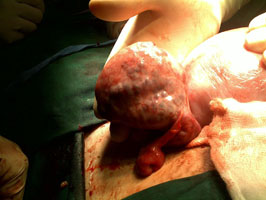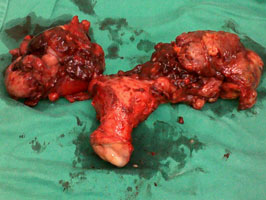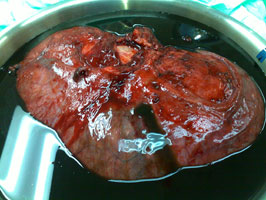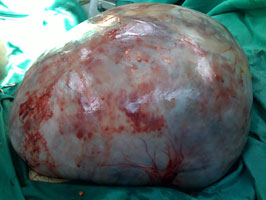Ovarian cancer is a cancer that arises from the ovaries. Ovaries are a pair of organs that produce eggs and hormones in the female. Ovarian cancer is common in women above 40 years and peaks among 55 to 60 years of age, but it can also occur in women of less than 20 years old. Most ovarian cancers arise from the surface of the ovary (epithelial cancer) and a fraction derived from the egg cells (germ cell cancer). Cancer of the ovaries are difficult to be detected early (as compared to cancer of the cervix (cervical) and the endometrium (lining of the uterus)) as the position of the organs lies deep within the pelvis. This makes the process of screening for ovarian cancer difficult.
Ovarian cancer tends to run in the family. It is higher if the woman has had a mother or sibling with similar cancer. It is also tends to occur in women who reach puberty early or attain late menopause. Ovarian cancer is associated with women who have never been pregnant, women who are pregnant at a later age and those with blood group ‘ A ‘.
Causes of Ovarian Cancer
No one knows the exact cause of ovarian cancer. Previously talcum powder applied to the vulva had been associated with ovarian cancer and this prompted a study done in South Africa. It was later found that the talcum powder used had contained a high level of asbestos. Talcum powders nowadays no longer contain asbestos and it is found to be safe to use.
Other factors e.g. viral infection have also been studied, however, no significant correlation was detected between viral infections and ovarian cancer.
Symptoms / Signs of Ovarian Cancers
In its early stages, ovarian cancer usually has no specific symptoms. Some women may experience bloating, whilst some may be suffering from diarrhea or constipation. These conditions are often thought to be due to common intestinal problems and unfortunately not given the attention it deserves.
Swelling in the abdomen at an early stage can occur and it is usually thought as normal weight gain. Severe pain is very rare, unless there is twisted ovarian cyst or there is bleeding in the ovaries. Swelling of the abdomen may be due to accumulation of fluid (ascites) produced by the ovarian cancer. This fluid makes the patient’s abdomen enlarged. Often, at this stage, the ovarian cancer has already spread.
 |
| Ovarian cancer can occur in a small ovary |
 |
| Ovarian cancer involving both ovaries |
How to Detect Ovarian Cancer
Many studies have been done to identify the test for ovarian cancer. Some use blood tests such as tumor antigen CA125, carcinoembryonic antigen (CEA), alpha-fetoprotein (AFP) and beta HCG. Others have used ultrasound scans. Some even are willing to undergo surgery to remove the organ ovary itself. Unfortunately there is no single effective method or economical method of screening.
There are 3 major groups of women who are given priority and encouraged to undergo screening for ovarian cancer. These are women with a close relative who have had ovarian cancer, those who carry the BRCA1 and BRCA2 ( high risk of ovarian and breast cancer ) and those who have close family members with colon cancer, uterine cancer and breast cancer . Blood tests for screening should be conducted on these 3 groups.
Diagnosis
Diagnosis is made by examining the patient and performing a few simple tests.
By clinical examination: the patient may have a hard mass in the pelvis or sometimes an ovarian cyst (a mixture of fluid and hard growth in the affected ovary).
By radiological examination: often with the use of ultrasound. The size and specific features of the tumor can help doctors to assess whether the tumor is cancerous or not.
By laboratory tests:blood test for tumor antigen CA125 is taken. It is a type of protein produced by ovarian cancer. Unfortunately CA125 protein is also produced by other non-cancerous conditions such as endometriosis, fibroids and inflammatory conditions of the peritoneal wall. The difference is the level of CA 125 in ovarian cancer is usually very high (at times approaching or surpassing 1,000 IU).
By surgery: this is the most accurate method to diagnose ovarian cancer. It will only be done after the above tests are performed and the patient is fit to undergo surgery. The level of disease (staging) will be made during the surgery and the tumor is removed as much as possible. Staging of the disease is based on the International Federation of Gynecology and Obstetrics (FIGO) staging.
 |
| Ovarian cancer after surgery |
 |
| Ovarian cancer after right after surgery |
How Ovarian Cancer Spread
Ovarian cancer can spread throughout the peritoneal space (the space between the pelvis to the base of the lungs). It is spread by the flow of peritoneal fluid. Spread always occurs into the lymphatic circulation. About 60 to 70 percent of cancer stage III would have spread to the pelvic and para-aortic lymph nodes. Spread through the blood stream is very rare. However, it can occur at a late stage, especially after patients undergo various treatments. By then the spread would have reached the spine, brain and lungs.
Emotional support
In addition to physical health, psychological health should also be emphasized. Family members and their partners should be consulted about treatment methods and moral support should be given.
Treatment
Treatment of ovarian cancer typically requires surgical removal of both the affected and normal ovaries, the womb and the omentum (layer of fat in the abdomen). If required, other affected organs e.g. colon may also undergo surgery. This is then followed by chemotherapy. Once the diagnosis of ovarian cancer is made, patients should be optimized for operation as soon as possible. Surgery is the first and the most important step to ensure (confirm) the diagnosis, to determine the extent of disease (staging), and to remove as much tumour as seen with the naked eye. As much cancer tissue as possible should be removed during surgery and no more than 1 cm of tissue should be left behind. Follow-up treatment such as chemotherapy or radiotherapy should be sorted out quickly. If chemotherapy is given too late there is a possibility that the cancer cells would proliferate or recur.
For women still in their reproductive age, conservative surgery where the uterus and perhaps one of the ovaries may be left behind.
Chemotherapy treatment
After completion of surgery, the patient may need chemotherapy drugs. The purpose of this drug is to kill off the ovarian cancer cells which may remain in the body of the patient. Chemotherapy can also be given before surgery.
The chemotherapy agents include the Taxane group (paclitaxel and docetaxel) and the platinum group (Cisplatin and carboplatin). Carboplatin is much in use now because of its low side effects. Other agents are cyclophosphamide, etoposide, Adriamycin (CAP), 5 fluorouracil and others are also use. Chemotherapy may be given as a single agent or in multi- agent (mixture). Mixed chemotherapeutic agents often are used for aggressive cancer cases, advanced cases, cases that have no response to platinum chemotherapy or recurrence cases.
Radiotherapy treatment
Radiotherapy is used to treat early stage of germ cell ovarian cancer. However, it is not widely used in other ovarian cancer as it is less effective on them and carry higher side effects. It can also damage vital organs such as the liver, kidneys, small intestine and colon.
Support organization
Cancer treatment is often expensive and costly. For cancer patients who need help they will usually be referred to the National Cancer Council (MAKNA)
| Last Reviewed | : | 4 December 2015 |
| Translator | : | Dr. Hj. Mohamed Hatta b. Mohamed Tarmizi |
| Accreditor | : | Dr. Haris Njoo Suharjono |







